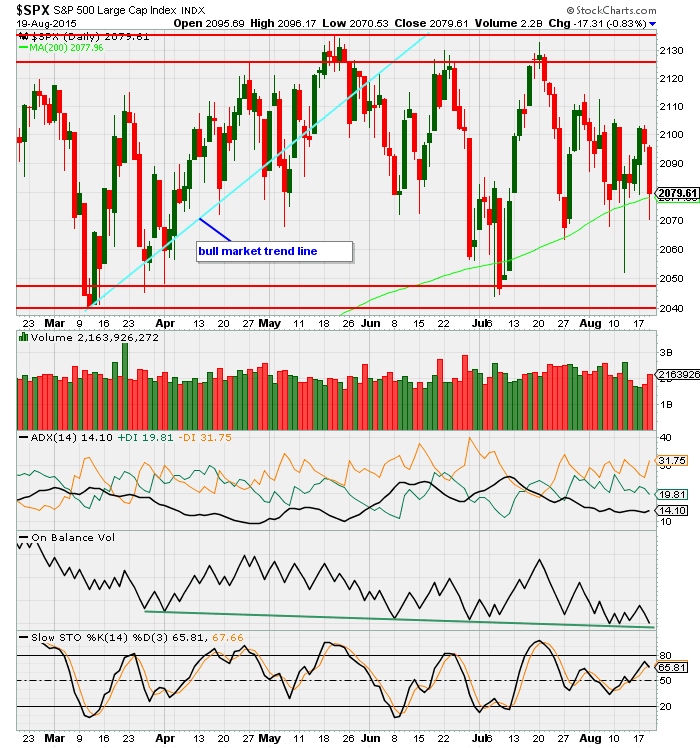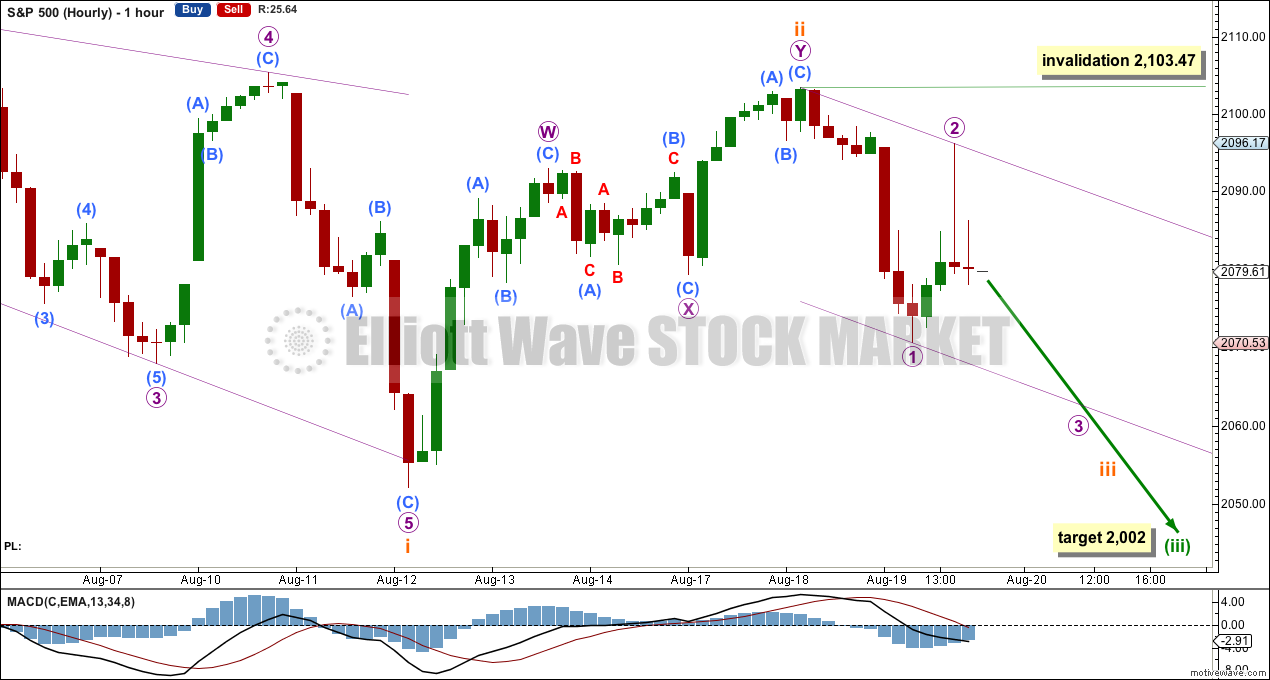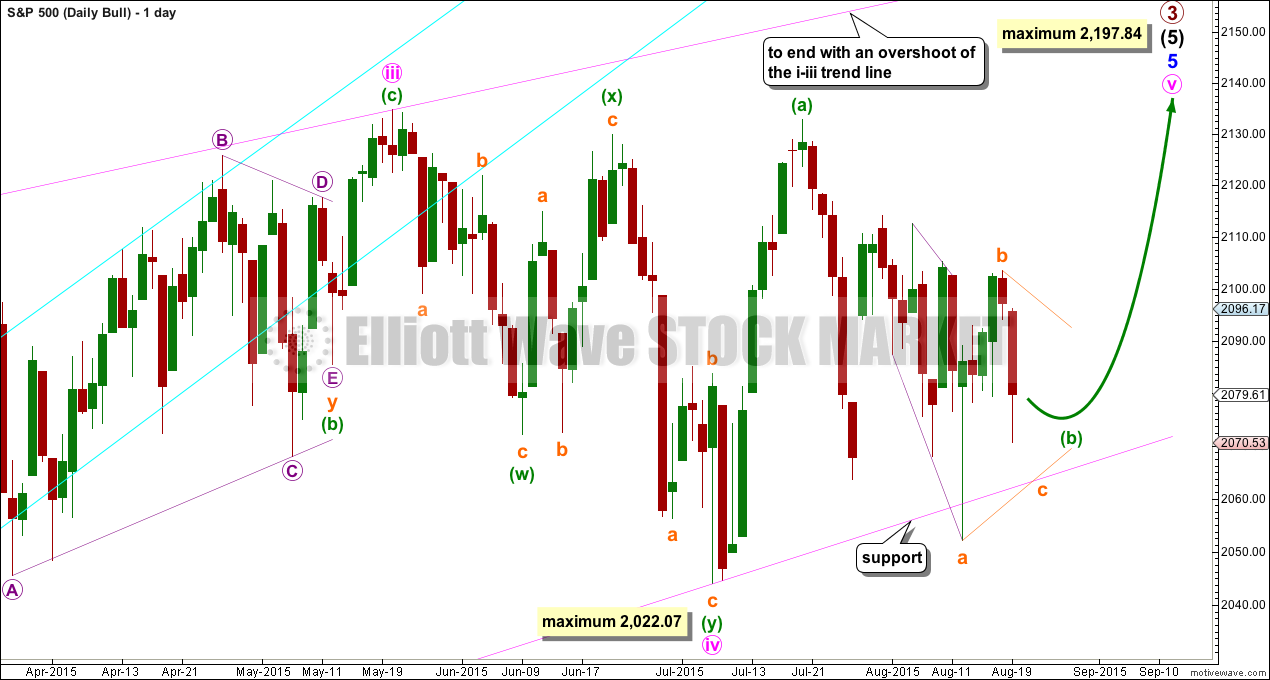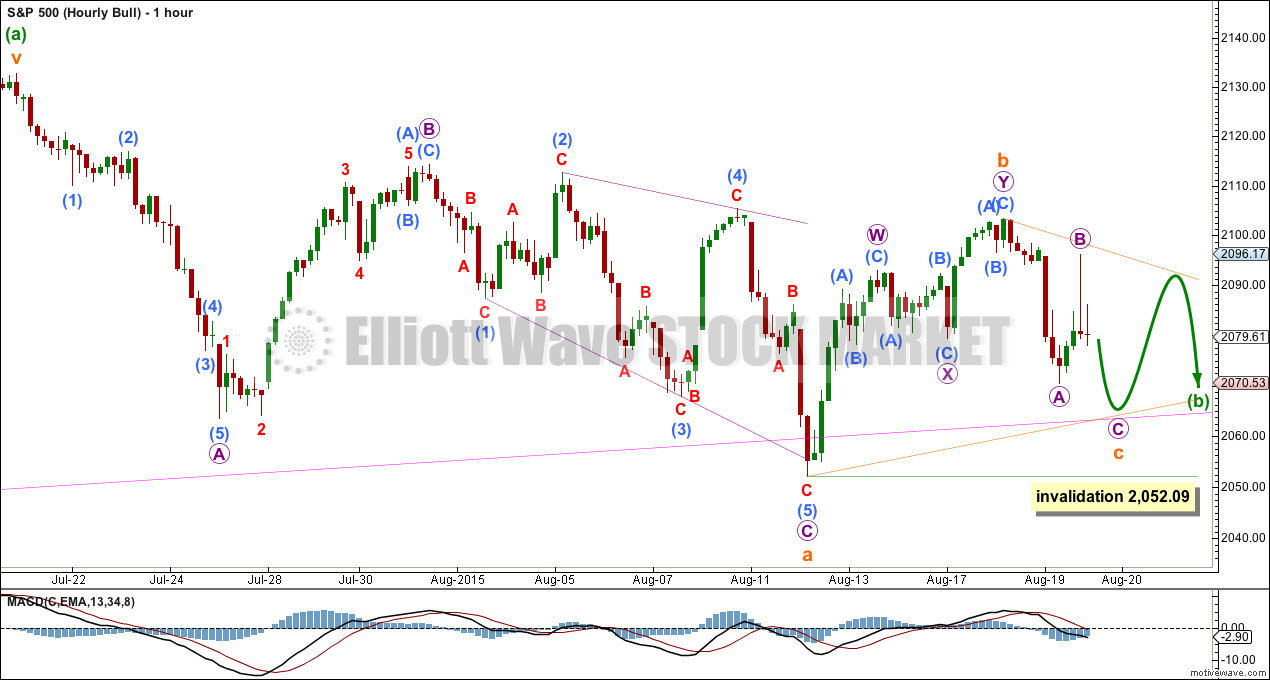Downwards movement was expected again for the first Elliott wave count.
Summary: The first wave count expects an explosive movement towards the downside, with a target at 2,002. The second wave count now expects some sideways movement before the upwards trend resumes. A new low below 2,079.30 would strongly favour the first wave count. A new high above 2,103.47 would favour the second wave count.
Changes to last analysis are bold.
To see a weekly chart and how to draw trend lines click here.
FIRST ELLIOTT WAVE COUNT
It is possible that the S&P has seen a primary degree (or for the bear count below a Super Cycle degree) trend change.
If primary wave 3 is over, then primary wave 4 should begin.
Primary wave 2 was a relatively shallow 0.41 zigzag lasting 12 weeks. Primary wave 4 may be more shallow and is most likely to be a flat, combination or triangle. It may be longer lasting than primary wave 2 as these types of sideways corrective structures tend to be more time consuming than zigzags. Primary wave 4 is likely to end in the price territory of the fourth wave of one lesser degree between 1,730 – 1,647. It may last about 21 or maybe now even 34 weeks.
This wave count now has some confirmation at the daily chart level with a close more than 3% of market value below the long held bull market trend line.
Further confirmation would come with:
1. A new low below 2,044.02.
2. A new low below 2,022.07 to invalidate the second wave count.
3. A clear five down on the hourly chart.
4. A clear five down on the daily chart.
5. A new low below 1,820.66.
6. A break below the 50 week SMA on the weekly chart or the 200 day SMA on the daily chart.
As each condition is met the probability of a substantial trend change would increase.
At this stage, a trend change is looking somewhat likely so I’ll list points in its favour:
1. The long held bull market trend line, the strongest piece of technical analysis on ALL charts, has been breached now by a close more than 3% of market value.
2. There is quadruple negative divergence between price and MACD on the weekly chart.
3. There is double negative divergence between price and MACD on the daily chart.
4. There is persistent and strong negative divergence between price and RSI on the monthly chart. The last time this happened was October 2007 and we all know what happened after that…
5. A long held bull trend line on On Balance Volume going back to October 2014 has been breached, is no longer providing support, and is now providing resistance.
6. DJT has recently failed to confirm the continuation of a bull market. This does not indicate a bear market, but does indicate caution.
At 1,983 minute wave iii would reach 4.236 the length of minute wave i. This is the ratio I am using for this target because minute wave i was short and minute wave ii was deep.
Minute wave iii should show its subdivisions clearly on the daily chart, so that when it is done it has a clear five wave impulse look to it. So far minuette wave (ii) shows up clearly. When it arrives minuette wave (iv) should also show up clearly. Minuette wave (iii) should show a strong increase in downwards momentum.
On the five minute chart, micro wave 1 subdivides perfectly as an impulse and micro wave 2 will not fit as an impulse; micro wave 2 may be a zigzag or zigzag multiple. Again, there are fives down and corrective movements up favouring this first wave count over the second.
This first wave count now has four overlapping first and second waves. This indicates a winding up of potential energy. When this potential energy is released, then movement may be explosive to the downside. If targets are wrong, then they may not be low enough.
At 2,002 minuette wave (iii) would reach 1.618 the length of minuette wave (i).
Micro wave 2 may not move beyond the start of micro wave 1 above 2,103.47. Micro wave 2 is already a very deep second wave, 0.78 of micro wave 1, and is most likely to be over here. Micro wave 2 is not showing up as a green candlestick or doji on the daily chart, so if it is over then the following correction for micro wave 4 should also not show up on the daily chart. This wave count now expects the S&P500 to begin a free fall tomorrow to complete the structure for subminuette wave iii, the middle of a third wave.
Draw a base channel about micro waves 1 and 2. Micro wave 3 should have the power to break through support at the lower edge of the channel. Along the way down, corrections should find resistance at the upper edge of the channel.
SECOND ELLIOTT WAVE COUNT
The ending contracting diagonal may still be incomplete. Ending diagonals require all sub waves to subdivide as zigzags, and the fourth wave should overlap first wave price territory. It is Elliott wave convention to always draw the diagonal trend lines to indicate a diagonal structure is expected.
My labelling here of minute wave iv within the diagonal as a double zigzag relies upon the interpretation of “double and triple zigzags take the place of zigzags” (“Elliott Wave Principle” by Frost and Prechter, 10th edition, page 91) to be true for zigzags within diagonals. This wave down may also be labelled as a single zigzag, but that does not have as neat a fit as a double zigzag.
The diagonal trend lines are not as clearly converging as they are for the first wave count. This reduces the probability of this wave count.
If it moves any lower, then minute wave iv may not be longer than equality in length with minute wave ii at 2,022.07. If it is over here, then minute wave v up also has a limit and may not be longer than equality with minute wave iii at 2,197.84.
The best way to see where and when upwards movement may end is the upper diagonal i-iii trend line. It is very likely to be overshot.
This second wave count now must consider a different structure for minuette wave (b), which must be continuing. It may be a triangle as labelled or it may morph into a combination. Either way it should find support at the lower pink ii-iv diagonal trend line shown on the daily and hourly charts.
If minuette wave (b) is a triangle, then within it subminuette wave c may not move beyond the end of subminuette wave a below 2,052.09.
Subminuette wave c should not break below the pink trend line.
The triangle is not supported by MACD. Usually MACD hovers closer to the zero line while a triangle unfolds, but here it is not. MACD does not always behave like that for a triangle, so it is still possible.
Minuette wave (b) may also be a combination. That would allow a new low below 2,052.09, but because that would require a breach of the diagonal trend line the invalidation point at 2,052.09 should be respected for this wave count.
BEAR ELLIOTT WAVE COUNT
The subdivisions within cycle waves a-b-c are seen in absolutely exactly the same way as primary waves 1-2-3 for the main wave count.
In line with recent Grand Super Cycle wave analysis, I have moved the degree of labelling for the bear wave count all up one degree.
This bear wave count expects a Super Cycle wave (c) to unfold downwards for a few years, and if it is a C wave it may be devastating. It may end well below 666.79.
However, if this wave down is a Super Cycle wave (y), then it may be a time consuming repeat of the last big flat correction with two market crashes within it, equivalent to the DotCom crash and the recent Global Financial Crisis, and it may take another 8-9 years to unfold sideways.
Within the new bear market, no second wave correction may move beyond the start of its first wave above 2,134.72.
The second wave count above works in the same way for this bear wave count.
TECHNICAL ANALYSIS

Click chart to enlarge. Chart courtesy of StockCharts.com.
Downwards movement unfolded with increased volume again. Volume continues to favour the first wave count; this fall in price is supported by volume.
However, most recently, it was the upwards day of 12th August which has strongest volume. Overall, since the 13th of July when ADX began to indicate the market was consolidating, it is the upwards day of 12th August that has highest volume which would indicate an upwards breakout is more likely than downwards. This contradicts the rise in volume as price falls.
On Balance Volume is coming to again test an important trend line. This line is reasonably shallow, held now since 26th March, 2015, and has been tested five times. It is highly technically significant, and so may provide strong support.
The 200 day simple moving average continues to provide very strong support. It is rising to come closer to the upper horizontal resistance lines; price is being squeezed between them. Something will have to give. The breakout is getting closer.
If price manages to break below the 200 day SMA and the horizontal support lines, then that would be a very bearish indicator. If OBV manages to break below its trend line, then that too would be a very bearish indicator. While these lines and indicators hold, the short term outlook from this regular technical analysis point of view is bullish, but does not support the Elliott wave first count.
The strongest piece of technical analysis on this chart is the bright blue bull market trend line, which was long held (it began back in November 2011), repeatedly tested, and reasonably shallow. The trend line has been breached twice by daily closes more than 3% of market value, and now tells us the market has changed from bull to bear.
A note on Dow Theory: for the bear wave count I would wait for Dow Theory to confirm a huge market crash. For that to be confirmed the following new lows are needed:
S&P500: 1,820.66
Nasdaq: 4,116.60
DJT: 7,700.49
DJIA: 15,855.12
At this time DJT is closest, but none of these indices have made new major swing lows yet.
This analysis is published about 10:26 p.m. EST.






Bears on the prowl. They have been selling every attempt at a rally with absolute ruthlessness and it looks like buyers are starting to scatter. We should see at least a few days of free-fall until capitulation.
Looks like first Elliott wave count confirmed.
If you’ve had trouble trading the VIX, the current situation is the one you want to look for.
When UVXY pierces its upper Bollinger band intraday then closes below it at least two days in a row, and this generally happens only once or twice per year, it presents a high reward to risk shorting opportunity. If you use options, give yourself at least one month to expiration. There are not too many sure things when it comes to trading equities…this is as close as it gets. Merry early Xmas!
Vernecarty do you have any target for VIX? Nice call Lara. The heavy selling appears to have begun.
VIX can be a bit tricky as it does not always correspond precisely with where the indices are trading. At the last major low back in October it spiked to about 31.
I fully expect this decline is going to eventually take out those lows so it could spike higher. Any reading above 20 is more than likely signaling at least an intermediate bottom is approaching and at that point I watch the Bollinger bands for setting up a short position. Two consecutive closes back within the bands after over-shooting the upward band generally provides a good entry point.